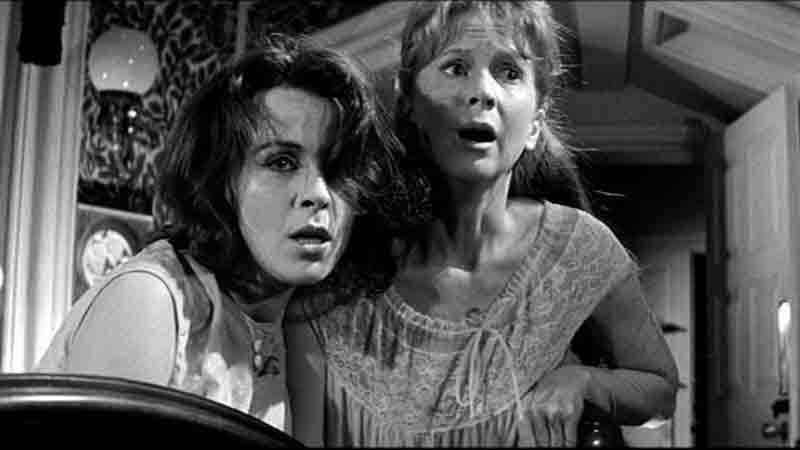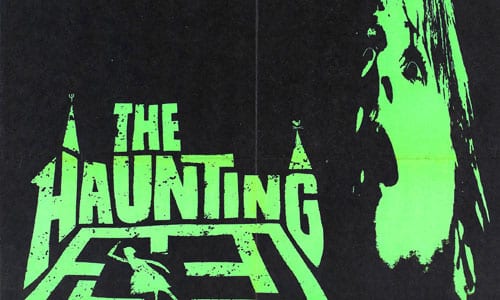The Haunting 1963 is an atmospheric, clever, character driven piece of work, says JON KANEKO-JAMES

TITLE: The Haunting
YEAR RELEASED: 1963
DIRECTOR: Robert Wise
CAST: Julie Harris, Claire Bloom and Richard Johnson
The Haunting is a bit of a bumblebee: it shouldn’t work, and it breaks a lot of the laws of ‘good’ film.
Some of you will disagree: you might point out that it was produced and directed by the Robert Wise, the man who basically stands behind a calculable proportion of the greatest films ever (Citizen Kane, The Day the Earth Stood Still, The Andromeda Strain.)
Some people might give him extra props for having the balls and humility to be the sort of director who doesn’t have a personal ‘style,’ saying famously that he allowed the film itself to dictate his style (others amongst you – mad, crazy people – might see Wise’s awards record and suggest that his personal style is ‘walks away with a goddamn trophy.’) For this reason, you might say that if a man can win awards for Citizen Kane, West Side Story and a dozen other things has a bit of range, he knows about film.

The Haunting was adapted by Nelson Gidding, the man who also adapted The Andromeda Strain. Apparently there are some people who didn’t like what he did with The Hindenburg 1975. Despite this, some of you might still try to say that he knows something about film.
You’d be wrong, and it’s a great thing, because if someone ‘who knew things about film’ had been involved in the production, it wouldn’t have been the same.
The Haunting has everything that people hate about films like Dune: opening up with narration, bad acting from the supporting cast, yet more narration to explain the main protagonist’s inner monologue and creating tension via the Irwin Allen Rock and Roll effect (you’ll have seen it on Star Trek, when the camera rolls from side to side and people throw themselves across the set.)
Yet it’s an amazing movie. Stephen King and Stephen Spielburg have both cited it as a huge influence on their film making. For me personally, it was the first horror film I was allowed to stay up late to watch, and it played directly on the real fears of being alone in the dark.
The plot isn’t anything particularly special: Dr Markway, (played by Richard “Bulldog Drummond” Johnson) gathers a group together in a haunted house for the purposes of psychic research. The House, Hill House, was last occupied by Abigail Crane, an elderly recluse who lived and died in a single nursery room after the death of her bitter, fundamentalist Christian father, Hugh Crane.
The Opening of The Haunting 1963
The Haunting 1963 opens with a voiceover from Markway explaining that the house is haunted after a series of tragedies suffered by the women of the house: Crane’s first wife was killed the first time she tried to visit the house, while his second wife mysteriously fell to her death.
Abigail herself is said to have died while calling for help as her nurse-carer fooled around with a local farmhand. Markway explains that he was able to lease the house from the nurse-carer’s family, after the girl went mad, hanging herself in the library.
And so we come to the team: Dr. Markway, Anthropologist and Parapsychologist; Luke Sannerson, the son of the house’s current owner; the confident, bohemian psychic Theodora; and the sheltered, jittery Elinor Lance.
Things open with the usual horror film stuff as the odd servants, the Dudleys, set the scene with the now-stanadard “We don’t come up her after dark, sirs,” fare, and get on with some rather unsurprising buildup where various supernatural events occur and Markway debunks them.
On the first night Theodora (‘Theo’) and Elinor (‘Nell’) are terrorised by the sound of some huge creature hammering against their door.
The scene shows nothing little other than the faces of actresses Claire Bloom and Julie Harris (Theo and Nell respectively,) reacting to the sound of something inhumanly large hammering against an unmoving door. Tension mounts in a play of fear aggravating fear until Nell realises that the door isn’t unlocked, at which point the handle itself starts turning.
As the days go on the chief tensions aren’t directly because of the supernatural incidents, but the dynamics between our three ghost hunters.
In one stream we have the one way pull of attraction between Nell and Dr. Markway, with a jealous Theo on the outside. Theo is affectionate to Elinor, but turns to hurtful sarcasm whenever the more innocent girl shows any affection for the married anthropologist.
Elinor doesn’t have the social skills to understand that her attraction to Markway is pure infatuation and is devastated when Mrs. Markway shows up on the last day. In fact, in one theory the ‘cause’ of the events in Hill House has been named as Elinor’s latent psychic ability, which would make Mrs. Markway’s fate all the more poignant.
That brings us to the second dynamic: the reaction of the other characters to Nell’s position as the hub of supernatural activity in Hill House.
From the start, Nell resonates with the house: she is the first to experience what might be a flash of empathy with the spirit of the house (a moment of hysterical fear offset by Dr. Markway opening a door and switching on the lights.) The story of the house’s alleged ghost, which Elinor as anthropomorphises as the spirit of the house itself, and the death of Abigail Crane resonate with her own experience caring for her mother, and her mother’s death.
In fact, for Elinor the whole chain of events that occur in The Haunting 1963 are a case of plus ça change: her domestic situation is tenuous, but when she goes to Hill House every supernatural event jeopardises her position on the project; she is terrorised by guilt from the death of her mother, and in Hill House she is terrorised by the literal ghost of Abigail Crane who died, unattended, in her sick room; she feels like a subordinate – a shadow in her own life – and at Hill House she finds herself subordinated to the dashing Dr. Markway and the glamorous Theo.
Supernatural events catalysts for drama
Even the supernatural events that happen are more catalysts for the drama around Elinor. She’s afraid while things are happening, but from the off we see much more drama from her companions reactions than the incidents themselves: when the terrible creature starts hammering at the door of the room where Elinor and Theo are sitting, Elinor is quickly set aside for the interplay between Luke, Markway and Theo. Elinor is the hub of the story, but only in the sense that she remains still and things revolve around her.
Returning to the action of the film, the supernatural events rise to a steady peak, and we get some of the best scenes. On the second night Dr. Markway asks Elinor and Theodora to sleep in the same room, where Elinor and Theo simultaneously get on each other’s nerves and bond, with Elinor fantasising about her ideal life. Once they sleep, Elinor is awakened in during the night to phantom sounds, thinking that Theo is holding her hand (she isn’t).
Elinor stares fixedly at a face formed from the leaf patterning on the wall, hearing Hugh Crane terrorising his daughter. They find a disturbing hand made book in the library where the nurse-carer killed herself, depicting Hugh Crane’s self hating, apocalyptic brand of Christianity.
Finally, Dr. Markway’s wife appears, telling him that the national press are waiting outside to run lurid articles on the nature of their work.
Even this revolves around Elinor without really allowing her any opportunity to affect her environment: Grace Markway triggers the movie’s endgame by insisting on sleeping in Abigail Crane’s nursery and death-room. Her disappearance and subsequent temporary madness inflame Elinor into thinking that Grace Markway has stolen her place as the House’s chosen in the same way that she supplanted Elinor’s dreams of Markway’s affection. Key, though, is the fact that Elinor has no agency in the matter: Markway is securely married, and although the film hints that he’s unhappy with his wife, there’s no question of his leaving her for Elinor.
Finally, the spirits of the house run riot. Markway’s curiosity is overwhelmed by fear and the investigators are driven into the library. Elinor sacrifices herself to the house, running through a series of surreal scenes until she is finally rescued by Markway.
Even at the end, Elinor comes full circle: she is taking off in her semi-stolen car, homeless, fleeing people who claim to have her best interests at heart, but who still seem to want to control and infantilise her. Even the movie’s ultimate climax, and Elinor’s personal conclusion, has the world revolving around her in the most literal way: she is critical but helpless, a victim of events.
The Haunting 1963 is unpredictable and makes us think…
As I said earlier, this film wasn’t made by anyone who knew anything about film: Elinor often announces her thoughts in voiceover; the character of Luke, the heir apparent to Hill House, is shallow and almost totally uninvolved in any of the most important dynamics of the movie; the sound design is sometimes hokey and the camera work in certain scenes (the Irwin Allen effect during Elinor running through the house, the POV effect of when Elinor climbs the library stairs) are corny to modern tastes.
Even characters who don’t speak in voiceover often seem to announce what they’re thinking in simple, direct phrases.
So we’re agreed, whoever made The Haunting 1963 didn’t know anything about film… or so they’d like us to think. Like a kung fu master, Wise allows us to think he’s a nice old man with a cosy black and white ghost story, but it’s all a work of misdirection.
While Elinor is announcing her thoughts in voiceover and Theo is stating Elinor’s feelings for Markway, we get a lot more. We see the relationship between Elinor and Theo, and Theo’s jealousy that Elinor wants Markway. The simple effect of having Elinor terrorised by what might be a face on the wall taps into our fear of the dark, watching the curtains twitch as a child. We wonder whether Theo is really psychic, or just deeply manipulative, trying to entrap Elinor into yet another relationship of control and submission.
So if you have any empathy for your fellow human beings, and you have even the tiniest store of patience, I recommend The Haunting 1963.
It’s an atmospheric, clever, character driven piece of work.
Tell us what you think of The Haunting 1963 in the comments below!
Discover The Haunting 10 Creepy Facts You Didn’t Know!

